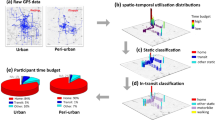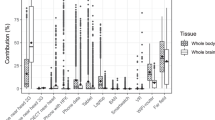Abstract
The Electromagnetic Fields and Breast Cancer on Long Island Study (EBCLIS) is a large population-based case–control study investigating possible associations between magnetic fields and breast cancer, and includes a comprehensive set of in-home measurements. We investigated the reproducibility of wire codes, their relation to 24-h measurements of residential magnetic fields, and potential influences, such as housing characteristics, in homes of the 1161 EBCLIS participants. Replicate wire coding was performed in homes originally categorized as having very high current configurations (VHCC) in the Wertheimer–Leeper (W–L) wire coding scheme, and a random sample of other homes (235 residences). Reproducibility was very high, with a κ statistic of 0.83 (95% confidence interval (CI)=0.77–0.89) for the five-category W–L wire codes and 0.91 (95% CI=0.86–0.95) for the three-category Kaune–Savitz (K–S) codes. As levels of W–L and K–S wire codes increased, the mean and median 24-h levels of broadband and harmonic fields in the residences also increased, indicating an association between wire codes and magnetic fields measurements. Regions of Long Island with the highest percentage of homes built before 1950 had the highest percentage of higher current configuration homes, as well as the highest average 24-h broadband and harmonic measurements. Adjustment for age of the home and region did not affect the relation between wire codes and measured magnetic fields. Our results indicate that: (a) a high reproducibility in wire coding was achieved, (b) wire codes were correlated with magnetic fields, and (c) wire code levels were related to the age of the home. The high level of reproducibility suggests that, in our case–control analyses, there will be minimal bias due to misclassification of wire code categories. Results also suggest that wire codes are a proxy measure, to some degree, for current in-home magnetic field measurements in this study.
This is a preview of subscription content, access via your institution
Access options
Subscribe to this journal
Receive 6 print issues and online access
$259.00 per year
only $43.17 per issue
Buy this article
- Purchase on Springer Link
- Instant access to full article PDF
Prices may be subject to local taxes which are calculated during checkout
Similar content being viewed by others
References
Agresti A. Categorical Data Analysis. John Wiley and Sons, New York, 1990, pp. 100–102.
Bracken M.B., Belanger K., Hellenbrand K., Addesso K., Patel S., Triche E., and Leaderer B.P. Correlates of residential wiring code used in studies of health effects of residential electromagnetic fields. Am J Epidemiol 1998: 148: 467–474.
Caplan L.S., Schoenfeld E.R., O'Leary E.S., and Leske M.C. Breast cancer and electromagnetic fields—a review. Ann Epidemiol 2000: 10: 31–44.
Davis S., Mirick D.K., and Stevens R.G. Residential magnetic fields and the risk of breast cancer. Am J Epidemiol 2002: 155(5): 446–454.
EMCALC User Manual. Version 2.1. EPRI Electric and Magnetic Field Digital Exposure System. Entertech Consultants, California, 1993.
Fleiss J.L. Statistical Methods for Rates and Proportions, 2nd edn. John Wiley and Sons, New York, 1981.
Gammon M.D., Neugut A.I., Santella R.M., Teitelbaum S.L., Britton J.A., Terry M.B., Eng S.M., Wolff M.S., Stellman S.D., Kabat G.C., Levin B., Bradlow H.L., Hatch M., Beyea J., Camann D., Trent M., Senie R.T., Garbowski G.C., Matteo C., Montalvan P., Berkowitz G.S., Kemeny M., Citron M., Schnabel F., Schuss A., Hajdu S., Vincguerra V., Collman G.W., and Obrams G.I. The Long Island Breast Cancer Study Project: description of a multi-institutional collaboration to identify environmental risk factors for breast cancer. Breast Cancer Res Treat 2002: 74: 235–254.
Greenland S., Sheppard A.R., Kaune W.T., Poole C., Kelsh M.A., for the Childhood Leukemia-EMF Study Group. A pooled analysis of magnetic fields, wire codes, and childhood leukemia. Epidemiology 2000: 11: 624–634.
Kaune W.T., and Savitz D.A. Simplification of the Wertheimer–Leeper wire code. Bioelectromagnetics 1994: 15: 275–282.
Kleinbaum D.G., Kupper L.L., and Muller K.E. In: Payne M. (Ed), Applied Regression Analysis and Other Multivariable Methods. PWS-Kent Publishing Company, Boston, MA: 1988, (Chapter 17: One-way analysis of variance. pp. 341–386).
Linet M.S., Hatch E.E., Kleinermann R.A., Robison L.C., Kaune W.T., Friedman D.R., Severson R.K., Haines C.M., Hartsock C.T., Niwa S., Wacholder S., and Tarone R.E. Residential exposure to magnetic fields and acute lymphoblastic leukemia in children. N Engl J Med 1997: 337: 1–7.
London S.J., Thomas D.C., Bowman J.D., Sobel E., Cheng T.-C., and Peters J.M. Exposure to residential electric and magnetic fields and risk of childhood leukemia. Am J Epidemiol 1991: 134: 923–927.
Olsen J.H., Nielsen A., and Schulgen G. Residence near high voltage facilities and risk of cancer in children. BMJ 1993: 307: 891–895.
Preston-Martin S., Navidi W., Thomas D., Lee P.J., Bowman J., and Pogoda J. Los Angeles study of residential magnetic fields and childhood brain tumors. Am J Epidemiol 1996: 143: 105–119.
Rankin R.F., Bracken T.D., Senior R.S., Kavet R., and Montgomery J.H. Results of a multisite study of U.S. residential magnetic fields. J Expos Anal Environ Epidemiol 2002: 12: 9–20.
SAS Institute, Inc., Version 8. Cary, NC, USA. Copyright 1999.
Savitz D.A. Radiation II: Electromagnetic fields. In: Steenland K., Savitz D.A. (Eds.), Topics in Environmental Epidemiology. Oxford University Press, NY, 1997, pp. 295–313, Chapter 13.
Savitz D.A., and Kaune W.T. Childhood cancer in relation to a modified residential wire code. Environ Health Perspect 1993: 101: 76–80.
Savitz D.A., Wachtel H., Barnes F.A., John E.M., and Tvrdik J.G. Case–control study of childhood cancer and exposure to 60-Hz magnetic fields. Am J Epidemiol 1988: 128: 21–38.
Schoenfeld E.R., Henderson K., O’Leary E., Grimson R., Kaune W., and Leske M.C. Magnetic field exposure assessment — a comparison of various methods. Bioelectromagnetics 1999: 20(8): 487–496.
Schoenfeld E.R., O’Leary E.S., Henderson K., Grimson R., Kabat G.C., Ahnn S., Kaune W.T., Gammon M.D., and Leske M.C., for the EBCLIS group. Electromagnetic fields and breast cancer on Long Island: a case–control study. Am J Epidemiol 2003: 158.
Siegel S. Nonparametric Statistics for the Behavioral Sciences. McGraw-Hill Book Company, Inc., New York, 1956. (Chapter 8: The case of k independent samples, pp. 174–194 and Chapter 9: Measures of correlation and their tests of significance. pp. 213–223.)
Stevens R.G. Electric power use and breast cancer: A hypothesis. Am J Epidemiol 1987: 125(4): 556–561.
Tarone R.E., Kaune W.T., Linet M.S., Hatch E.E., Kleinerman R.A., Robison L.L., Boice J.D., and Wacholder S. Residential wire codes: reproducibility and relation with measured magnetic fields. Occup Environ Med 1998: 55: 333–339.
U.S. Census Data, 1990. website: http://landview.census.gov/main/www/cen1990.html for the zip codes in Nassau and Suffolk counties (income and education).
Wertheimer N., and Leeper E. Adult cancer related to electrical wires near the home. Int J Epidemiol 1982: 11(4): 345–355.
Acknowledgements
This work was supported by Grant #CA/ES 62991 and #CA/ES 66572 from the National Cancer Institute/National Institute of Environmental Health Sciences. We thank the study participants, our Scientific Advisory Committee: David A. Savitz, PhD (chair); Louise Brinton, PhD; Fred Dietrich; Norma Logan; Richard Stevens, PhD and Sholom Wacholder, PhD; Local Advisory Committee: Mary Dowden, Miriam Goodman, and Mary Joan Shea; and wire mapping technicians: Lynn Lavacca, Karen Hoagland, Edith Hoffman, and Sylvia Sananiego.
Author information
Authors and Affiliations
Consortia
Corresponding author
Additional information
1. Electromagnetic Fields and Breast Cancer on Long Island Study (EBCLIS) Group: Stony Brook: M. Cristina Leske, MD, MPH (PI); Sang Ahnn, PhD; Judith M. Greene, MPH; Roger Grimson, PhD; Kevin Henderson; Geoffrey C. Kabat, PhD; Erin S. O'Leary, PhD; Elinor Randi Schoenfeld, PhD. WESTAT: Carol Haines, MPH; Jacqueline Slattery-Telonidis. EM Factors: William T. Kaune, PhD. Long Island Breast Cancer Study Project: Marilie D. Gammon, PhD (PI); Julie A. Britton, PhD; Alfred I. Neugut, MD, PhD; Susan L. Teitelbaum, PhD
Rights and permissions
About this article
Cite this article
O'Leary, E., Schoenfeld, E., Henderson, K. et al. Wire coding in the EMF and Breast Cancer on Long Island Study: relationship to magnetic fields. J Expo Sci Environ Epidemiol 13, 283–293 (2003). https://doi.org/10.1038/sj.jea.7500280
Received:
Accepted:
Published:
Issue Date:
DOI: https://doi.org/10.1038/sj.jea.7500280
Keywords
This article is cited by
-
Gene–environment interactions between JAZF1 and occupational and household lead exposure in prostate cancer among African American men
Cancer Causes & Control (2014)
-
The Long Island Breast Cancer Study Project
Nature Reviews Cancer (2005)



